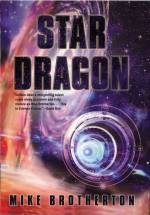Search
Return to the Moon? Good Idea or Bad?
June 4th, 2008
Gregg Easterbrook wrote an Atlantic June 2008 article “The Sky Is Falling” in which he argues for more attention to the issue of near-Earth asteroids, which I think are very much worth paying attention to. He also suggests that establishing a sustainable moon base is a waste of effort.
Do you agree?
My friend and fellow sf author Jeffrey Carver doesn’t think so. He’s written them a very insightful letter that I hope they’ll publish:
Dear Editor:
Gregg Easterbrook gets it half right in “The Sky is Falling” (The Atlantic, June 2008). He argues incisively for the need for those in the space community to take seriously the planetary threat of wayward asteroids and comets. NASA isn’t interested, as Easterbrook says, and the Air Force is hardly seizing on it with gusto, either. I spoke recently with a USAF officer whose job is strategic planning, and his unofficial comment was that the Defense Department could be considered criminally negligent in its failure to recognize planetary defense as a crucial part of its job description. If an asteroid-strike occurs (or threatens), are NASA and the Air Force just going to shrug and say “Not my job”? As Easterbrook says, that needs to change.
Where he gets it wrong is his dismissal of the return-to-the-moon program as a waste of money, detracting from other efforts. While balancing funding is always difficult (and the space budget is vastly smaller than most people think, accounting for only about half of one percent of the U.S. budget), a return to the moon could be a promising next step indeed. Learning to homestead other worlds is the next step toward what Captain Kirk famously called “the final frontier.” The point is not that a lunar base will be a launch point for a Mars mission–no one suggests that. It is that living on the moon will give us necessary experience for future exploration (to Mars and elsewhere), in a place where help is three days’ travel time away, not six to twelve months’ travel time. Further, a moon base could be the first place for serious mining of extraterrestrial resources, signaling the beginning of the end of humanity’s sole reliance on Earth-based metal and energy resources. Why mine minerals on the moon? Well, if you want to get metals into space–for example, to build satellite-based solar energy systems to beam nonpolluting energy to Earth–it’s potentially a lot cheaper and easier to lift tonnage from the low-gravity moon than from Earth, especially if you build solar-powered electric launchers for the purpose. This is a good argument for mining asteroids, as well.
This brings us back to the wayward asteroid and comet problem. While Easterbrook mentions several promising technologies, the best
long-term solution may be to build an infrastructure for living and working productively in space–not just one low-Earth space station, but a community of space habitations, complete with multiple, varied, and redundant transportation systems. Instead of hoping someone can get off a nuke to deflect one of those wayward asteroids, let’s build a permanent capability to move large objects in orbit. If a deadly ball of rubble comes along, we could nudge it away. If a metal-bearing asteroid comes along, we could move it to a parking orbit. Then, instead of watching it destroy our civilization, we could turn it into a mineral-lode, and put it to work building our new future in space.
By the way, I don’t work in the space program, or for the military or the government. I’m writing as a concerned citizen. My occupation is writer, and my latest novel, Sunborn, is forthcoming in the fall.
Thanks. –Jeffrey A. Carver
Note: Originally this was just “return to the moon” rather than “establish sustainable moon base.”
You can follow any responses to this entry through the RSS 2.0 feed. You can leave a response, or trackback from your own site.


Was Easterbrook talking about all possible returns to the Moon or the Vision for Space Exploration? The second struck me at the time as Space Exploration Initiative Mark II and look where that got the US.
Jeffrey Carver is correct, nice to see a piece that for once looks on the bright side of asteroids.
James, yes, good point. I wasn’t clear enough here as there’s a world of difference between “return to the moon” and “establish a sustainable moon base.” I’ve made some minor edits to reflect this.
I’ve since read the Easterbrook and am having surgery scheduled to have my eyebrows moved back down to their usual location. I am extremely sceptical that anything 3 – 5 km across has hit the Earth in historical times.
Is there an online source for the Dallas Abbott research? All I am finding are popular science accounts.
The thing that bothers me about Carver’s letter and a lot of pro-space arguments that I read online [1] is that they aren’t saying anything that wasn’t said 30 years ago. As it turned out, O’Neill’s solar ponzi scheme failed to attract investors and as technology currently stands, the cost per kilowatt of SPS is still prohibitive.
1: Although better elderly arguments than the nonsense that gets tossed around about lunar 3He.
I agree with James Nicoll on the justification of a moon base and pro-space arguments.
Building a moon base at our current level of technology would be like the people of the 19th century trying to colonize Antarctica to take advantage of the copious supply of fresh water. It would be a boondoggle of monumental proportions returning nothing on investment that we cannot get with unmanned probes and instruments.
I think our current space budget would be good value for money, if the illogical and useless manned side of it were jettisoned in favor of more probes, telescopes, and landers. Let the private sector spend money on weightless joy rides, not NASA.
I think there’s a false dichotomy present in the thinking here, that I’ve pointed out before on this topic. Why is it either manned exploration or unmanned exploration? In my opinion, there are different reasons to proceed with both, and they shouldn’t be funded as if they’re the same thing. Manned exploration shouldn’t be exploration — it should be leaving the cradle and learning how to live beyond Earth for a variety of reasons. Too often it’s pitched as science, which I agree is a weak argument to make. Lunar telescopes are one exception, and manned presence is probably needed there to do what I’d like to see done.
Like most reasonable people, I want to pave Lunar Farside with telescopes but it’s not clear to me that having humans on-site is all that useful as far as commiting astronomy goes.
At the risk of channeling my internal Jonathan vos Post, I once had a discussion with Yoji Kondo about whether Lunar mining operations were compatable with Lunar telescopes. I thought that to some extent one could cause complications for the other due to the fact that they’d produce effluent that would rapidly spread through the entire Lunar atmosphere (and in fact, could come to dominate it) while he thought I was being a pesky nitwit.
I was probably relaying the ideas in this
http://www.islandone.org/Settlements/DegradeLunarVacuum.html
ineptly.
My understanding of the crewed/uncrewed funding dynamic is that while funds can be denied to uncrewed operations so that they can be transfered to crewed efforts, the reverse never occurs.
I’ll have to look at that link, James, when I get the chance. My naive thought would be that without an atmosphere there won’t be an issue, but maybe the surface gravity is low enough a lot of particles are thrown up in orbits or semi-orbits.
And unfortunately you’re right that the reverse doesn’t seem to happen. I’m an idealist and want to see that changed. My own personal nightmare here, so maybe I’m in denial. I talked with a NASA official Monday briefly and my current long-term funding for my space science came up. I just put in my annual report, which should release my year four (of five) funding, and was told, “We’ll do what we can.”
Ouch.
[…] Jeffrey Carver wants us to revisit the moon. […]